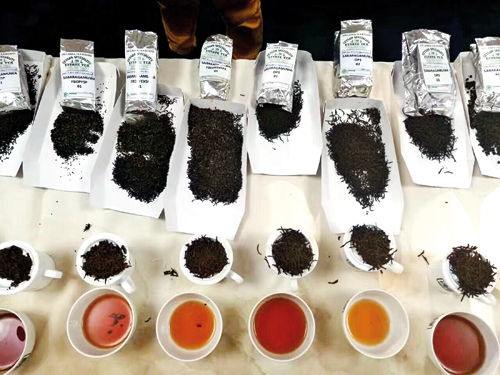Tea with milk in “Little England”
View(s):
The range of Ceylon Tea
After passing Gampola on our way to Nuwara Eliya, I decided to take a detour to visit my friend Sebastian Retty at his Orange Field Tea Factory. It has been one of the first few tea factories established in Sri Lanka during colonial times which continued to be in operation with renovation and modernisation afterwards, while most of the other old factories have ceased to exist by now.
Immediately after getting down from the vehicle, Sebastian offered us white aprons and hair covers to wear in order to protect our clothes from tea dust from the factory. Then, he took us inside the factory and started explaining about tea and tea processing activity step by step.
After tea leaves are plucked and brought before noon by small-holder farmers in the area, the tea collection enters tea processing on conveyer belts and through modern machines from the beginning to the end. It involves withering, rolling and twisting, oxidising, dehydrating, sorting and grading and packaging. There is a cleaning process too, because tea leaves come with not only sand and stones, but various metal and plastic objects such as hair pins, safety pins, buttons, nails and bolts.
Grading is amazing as it involves various categories of tea on the basis of colour, weight, size and aroma as preferred by differentiated customer demand around the world – some grades are for UK, some for Russia, some for Iran and so on.
Demand for residuals
Although we in Sri Lanka have been drinking tea for generations as our most common daily beverage, I wonder how many of us do care about the quality of tea that we drink! In fact, to say it bluntly, many people used to drink tea not for its “tea taste” but for its “sugar taste”.
Is it because we export the best quality tea to the international consumers who demand best quality and keep the leftovers for the local consumers? Or is it an inevitable outcome of our lower income levels, poverty, and lack of knowledge and exposure?
To substantiate the issue with facts, I was told that the tea residual in tea factories has a demand. Tea residual or fibre is a part that comes out in the sorting and grading activity, depending on the quality of tea leaves, while it consists of petioles and stems of tea. It is grinded to make powdered tea, which is mixed with chemicals to get the tea colour and sold in the local market at a cheaper price.
Poverty markets are fertile ground for such sub-standard products. Until and unless we eliminate poverty from this land with development, in fact with “inclusive development”, elements of poverty markets continue to haunt the society. It may be controlled with law and order, but law and order must be enforced and maintained.
Golf course, encroached
Whenever, I travel to Nuwara Eliya, I remember the remarks about it made by Lee Kuan Yew, the late Prime Minister of Singapore. He travelled to Nuwara Eliya in 1966, and wrote about the journey in his book, “Singapore Story – From Third World to First World”. The following is the quotation from page 462 of this book:
 “In Nuwara Eliya, I stayed at the former British governor’s hill residence, ‘The Lodge’. It was dilapidated. Once upon a time it must have been well-maintained, with roses (still some left) in the garden that looked like an English woodland. About 5,000 feet above sea level, it was pleasantly cool. I played golf on a once beautiful course; like the one in Colombo, this also was encroached upon by huts, goats and cows.”
“In Nuwara Eliya, I stayed at the former British governor’s hill residence, ‘The Lodge’. It was dilapidated. Once upon a time it must have been well-maintained, with roses (still some left) in the garden that looked like an English woodland. About 5,000 feet above sea level, it was pleasantly cool. I played golf on a once beautiful course; like the one in Colombo, this also was encroached upon by huts, goats and cows.”
Everything that Lee Kuan Yew remarked about Nuwara Eliya, except its “pleasantly cool” weather, was pointing to the city’s dilapidated status. In fact, this pleasantly cool weather and the landscape of Nuwara Eliya must have been the main reason for the British to re-discover it in the early 19th Century. They also built the city for them to remind them of their home country, England, and thus Nuwara Eliya was also called Little England.
“Little England”
Within less than 20 years later, as Lee Kuan Yew saw it, the bungalow was dilapidated, and the beauty of the garden faded away although some roses were still left there. And his remarks about the golf course are also a picture of its lawless and abandoned status. The golf course had been encroached by huts, goats and cows, as in Colombo.
Before coming to Nuwara Eliya, Lee Kuan Yew had already been to the Colombo Golf Course with Sri Lanka’s then Prime Minister, Dudley Senanayake. It was there he first saw that people had encroached the golf course by putting up huts, and grazing goats and cows.
More than half a century later, the hill country has been crowded with a growing population, while the city has become much more congested with people. I can’t say that we have improved much during the past, because Nuwara Eliya has a long way to go in order to project Little England once again from Nuwara Eliya.
Neither tea nor milk
Beautiful tea estates and dairy farms with green lush and misty hill tops outside the city remind us of areas in Europe, while the dilapidated status of roads, messy townships, and trash and trash bags thrown on either side of roads project a whole different environment.
Both tea and milk go together and are essential aspects of Sri Lankans living today. Nevertheless, in the island’s history, Sri Lankans have never been a tea-drinking or milk-drinking nation unlike other South Asian countries. Both these commodities have been introduced to Sri Lankan lifestyles during the colonial times by the European nations as part of the modern trends.
While British commenced tea plantations in the hill country of Sri Lanka by importing the tea plant from China and Northern India, they did not seem to have thought of initiating dairy farms in the country. Instead, they imported milk powder and promoted it among the Sri Lankans. The promotion has been highly successful too so that today it has become an essential part of Sri Lankan life.
Whatever that enters the day-to-day life of people, politics too enters there. During the post-independent times, accordingly politics entered into both tea and milk industries. Tea went through nationalisation in the 1970s, and then about 20 years later, privatisation. Nevertheless, the influential role of politics in the tea industry continues todate.
Tea and milk in politics
Politics in milk is playing an influential but different role by interfering in the import trade on the one hand, and by promising to achieve self-sufficiency in milk production on the other hand. Two sides of the arguments are contradictory as initiatives for self-sufficiency may require import controls but import controls may affect domestic milk supply and prices of dairy products as essential consumer goods.
Apart from that, one of the strategies to achieve self-sufficiency in milk production has been no different from promoting small-scale farming, as the strategy is to promote each household maintaining few cows. Small-scale farming in agriculture production in general has been practiced in Sri Lanka throughout its post-independent history.
It is true that the idea of maintaining small-scale agricultural farm plots or few cows for milking has a politically attractive romantic value. But its outcome has been less-romantic with respect to raising the living standards of households or contributing to economic development of the nation. Perhaps, tea estates and dairy farms in the hill country, managed by private companies teach us good economic lessons.
(The writer is a Professor of Economics at the University of Colombo and can be reached at sirimal@econ.cmb.ac.lk and follow on Twitter @SirimalAshoka).
Hitad.lk has you covered with quality used or brand new cars for sale that are budget friendly yet reliable! Now is the time to sell your old ride for something more attractive to today's modern automotive market demands. Browse through our selection of affordable options now on Hitad.lk before deciding on what will work best for you!


